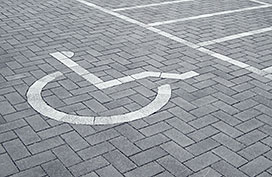Frequently Asked Questions
We're listing our "Top Twelve" Frequently Asked Questions about traditional and permeable paver design, construction and maintenance here, but for a comprehensive list of FAQs, just click the link below.
-
How long do UNI® concrete pavers last?
Individual pavers have a virtually unlimited lifespan – some installations in Europe have be in place for over 50 years and almost 40 years in North America. -
How soon after installation, can an interlocking concrete pavement be used?
Immediately. There is no curing or wait time to use the pavement, whether it is comprised of traditional or permeable pavers. -
Is there a structural difference between various paver shapes and do interlocking concrete pavers contribute to the pavement structure?
Yes. UNI® pavers feature interlocking designs that offer superior structural performance, especially under traffic loads. There have been many studies that have shown that interlocking pavements have the same or better load-spreading capability than an equivalent thickness of asphalt. -

Can the UNI® permeable pavers be used in freeze-thaw areas?
Yes. Because permeable interlocking concrete pavements are typically constructed with bases that have minimal to no fines and the pavement is still a flexible pavement like our traditional interlocking pavements, freeze-thaw does not present a problem. The void space in the aggregate base and subbase materials allow for expansion, minimizing heaving.
-
Can the ECO-STONE® Family of Permeable Pavers be snow plowed?
Yes. If properly installed, they can be snow plowed, just as with our traditional interlocking pavers. In fact, studies have shown that snow and ice melt quickly on PICP and drain through the surface, thereby minimizing icing hazards. The studies have also shown that less deicing salts are necessary on this type of pavement, reducing the impact on the environment. -
What is the infiltration rate of permeable interlocking concrete pavements?
The permeability and amount of infiltration are dependent on the infiltration rates of the aggregates used for the joint and drainage openings, the bedding, base, and subbase, and ultimately, the subgrade. Compared to soils, the materials used in Eco-Stone® permeable pavement systems have very high infiltration rates – from 500 in./hr (1270 cm/hr) to over 2000 in./hr (5080 cm/hr). This is far more pervious than any existing site soils. Though initial infiltration rates are very high, it is important to consider lifetime design infiltration of the entire pavement cross-section, including the soil subgrade when designing PICPs. Based on research to date, a conservative design rate of 10 in./hr (25 cm/hr) can be used as the basis for the design surface infiltration rate over a 20-year+ pavement life. As lifetime design infiltration rates may be difficult to predict, designers may want to use this conservative approach when calculating the design infiltration rate. -
What is the percentage of open area for UNI® Permeable Pavers and does this correspond to the infiltration capability?
One of the most common misconceptions when designing or approving permeable interlocking concrete pavement is the assumption that the amount or percentage of open surface area of the pavement is equal to the percentage of perviousness. For example, a designer or municipal agency might incorrectly assume that a 15% open area is only 15% pervious. While the percentage of open area for UNI® Permeable Pavers ranges from about 8 to a little over 12%, but this does not mean that only 8-12% of the rainfall infiltrates. Up to 100% infiltration rates are possible depending on design parameters and typically, PICP is designed to infiltrate the rainfall amounts generated by storms that comprise 75-85% of the design storms in the U.S. -

What about handicap accessibility of permeable interlocking pavements?
Permeable interlocking concrete pavement conforms to current ADA requirements that surfaces be firm, stable, and slip resistant. If the openings in the surface are not desirable, solid pavers can be installed in areas used by disabled persons. If there are changes to ADA design requirements in the future, UNI® permeable interlocking paver designs can be adapted to meet any potential new guidelines. If a smoother profile is desired for permeable pavements, our Eco-Priora® permeable paver features minimal chamfers and narrower joints and is a popular choice for pedestrian areas and handicap-accessible pavements. -
How are the infiltration rates for permeable pavements maintained?
All permeable pavements, including porous asphalt and pervious concrete, require periodic cleaning to maintain infiltration, and care must be taken to keep sediment off the pavement during and after construction. Research has shown that sediments tend to be trapped in the top 1 inch (25mm) or so of the joint and opening aggregate and it does not migrate down into the base and subgrade. This trapping of the sediment in the joints and openings allows for easy removal by street sweeping/vacuuming equipment. Street sweeping can provide preventative and restorative maintenance depending on the equipment used. Conventional broom sweepers can be used to remove the sediment crust in the openings and joints. However, regenerative air vacuum sweepers are more effective for maintenance of permeable pavements. The vacuum settings on sweeping equipment may require adjustment to prevent the uptake of aggregate in the pavement openings and joints during routine cleaning of fine sediments. For more severely clogged pavements, vacuum sweepers have demonstrated the ability to remove up to 3 inches or more of aggregate from the openings and restore the PICP to its original infiltration rates. It is recommended that pavements be cleaned once or twice per year, though low usage pavements may not require cleaning as often. See our Eco-Stone Permeable Pavement Maintenance Sheet for more information. -
How do permeable interlocking concrete pavements compare in cost to asphalt or concrete pavements?
PICP should not be compared to traditional asphalt or concrete pavements alone. They should be compared to these pavements, plus the cost for drainage improvements and possibly land area if required for retention or detention ponds. PICP allows for better use of available land, combining parking with detention, especially in urban areas. In addition, they are a better environmental choice and help meet stormwater runoff regulations and requirements. -
What types of areas are appropriate for interlocking pavers?
Interlocking concrete paving stones are used at airport, container faculties, railway container faculties, municipality streets, plazas, parks, driveways, walkways and patios. Pavers are the perfect solution for almost any applications because of their high quality, aesthetic value, and lower life-cycle cost in comparison to asphalt or concrete. -
Are continuing education credits or professional development hours on the design and specification of concrete pavers available?
Yes, UNI-GROUP U.S.A. manufacturers offer presentations that qualify for continuing education credits or professional development hours for registered architects or engineers for both traditional and permeable interlocking pavements.
Quick Links
- Traditional and Permeable Galleries
- Traditional Pavers
- Permeable Pavers
- Applications and Technical Data
- Installation and Specifications
- Design Manuals and Literature
- Software and Presentations
- Articles and Case Studies
- Cross-Sections
- Videos
- Visit our Downloads page to access over 175 items in one place, including design manuals, case studies, articles, research papers and more

